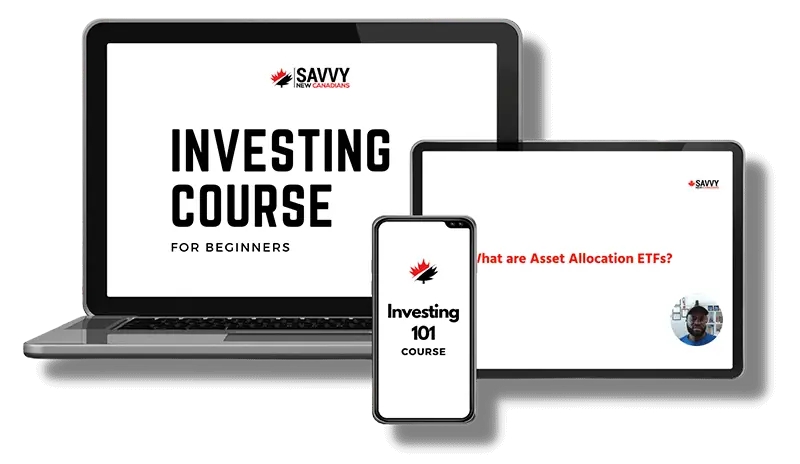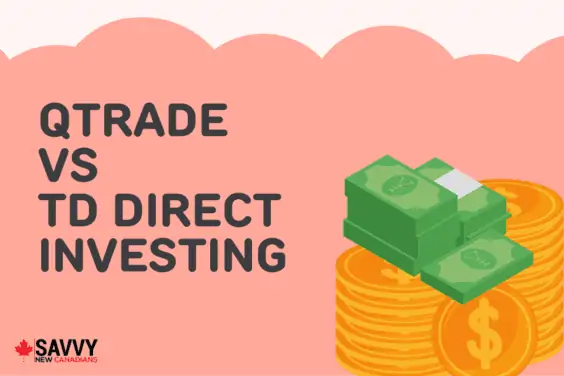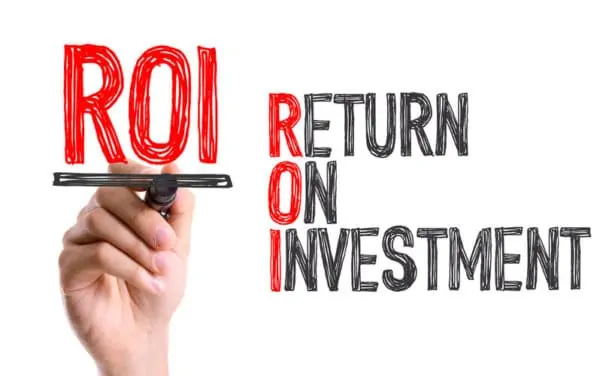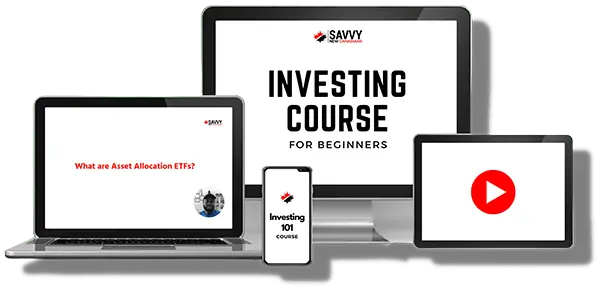Want to cut your investment fees while also avoiding the hassle of portfolio rebalancing and asset allocation?
An All-in-One ETF portfolio may be for you.
Fidelity recently added to the growing list of asset allocation ETFs in Canada when it introduced FBAL and FGRO in January 2021.
This FGRO review covers its holdings, fees, returns, pros, cons, how to purchase Fidelity ETFs in Canada, and how it compares to FBAL.
What is FGRO?
The Fidelity All-in-One Growth ETF (FGRO) is “designed for investors who are looking for long-term capital growth and want more emphasis on equity securities”.
This fund has a target allocation that is 85% equities (stocks) and 15% fixed income (bonds) securities.
Investors holding FGRO can expect their portfolio to experience more volatility than its balanced counterpart, FBAL (Fidelity All-in-One Balanced ETF).
Like FBAL, FGRO can be held in both registered (e.g. RRSP and TFSA) and non-registered personal and corporate investment accounts.
Some key facts for FGRO as of September 25, 2021:
- Inception date: January 21, 2021
- Net assets: $16.3 million
- Management Expense Ratio (MER): 0.39%* as of September 25, 2021
- Risk rating: Low-to-medium
FGRO Asset Allocation
As of July 31, 2021, FGRO was composed of 85.2% equities and 14.4% bonds with 0.50% in other investments.
Its investments in other Fidelity ETFs is based on a strategic allocation, with the top-10 including (as of June 30, 2021):
| FGRO ETF Holdings | Allocation |
| Fidelity U.S. High Quality Index ETF | 10.90% |
| Fidelity U.S. Value Index ETF | 10.88% |
| Fidelity Systematic Canadian Bond Index ETF | 10.86% |
| Fidelity U.S. Low volatility Index ETF | 10.67% |
| Fidelity U.S. Momentum Index ETF | 10.38% |
| Fidelity Canadian Value Index ETF | 5.45% |
| Fidelity Canadian Low Volatility Index ETF | 5.42% |
| Fidelity Canadian High Quality Index ETF | 5.41% |
| Fidelity International High Quality Index ETF | 5.27% |
| Fidelity International Momentum Index ETF | 5.27% |
In all, FGRO was made up of 16 underlying ETFs as of June 30, 2021.
The fund gives investors exposure to a portfolio that is diversified across sectors and markets.
FGRO’s top sector allocations are (as of June 30, 2021):
| Sector | Allocation |
| Financials | 17.44% |
| Information Technology | 13.11% |
| Industrials | 9.47% |
| Consumer Discretionary | 8.02% |
| Materials | 7.94% |
| Health Care | 7.43% |
| Consumer Staples | 5.52% |
| Real Estate | 4.92% |
| Communication Services | 4.89% |
| Utilities | 4.82% |
| Fixed Income | 16.44% |
FGRO’s top-market allocations as of June 30, 2021, are:
| Country | Allocation |
| United States | 43.22% |
| Canada | 34.73% |
| Japan | 5.30% |
| United Kingdom | 3.27% |
| France | 1.97% |
| Germany | 1.94% |
| Switzerland | 1.88% |
| Australia | 1.57% |
| Others | 6.12% |
FGRO Returns
If you are wondering about FGRO’s returns since inception, the performance data won’t be available until after its first calendar year. This is an industry-standard.
FGRO Fees
The Fidelity All-in-One Growth ETF has a Management Expense Ratio of 0.39%*, as of September 25, 2021. This translates to $3.90 per $1,000 invested per year.
Compared to the Canadian robo-advisors we have reviewed, which currently have average fees of 0.70% per year (includes the management fee and ETF MER), you could save money every year.
The fee savings can be significant. The fee comparison between All-in-One ETFs like FGRO and mutual funds does not take trading fees into consideration.
If you are buying small amounts of the ETF and are paying a brokerage commission, your fees will add up.
That said, you can avoid paying brokerage commissions altogether by using a brokerage platform that offers commission-free ETFs.
Pros and Cons of FGRO
Pros:
- Convenient to buy and removes the need for manual rebalancing.
- Provides global diversification that’s not easy to achieve if you are invested in individual stocks.
- Lower management expense ratio compared to some robo-advisors and mutual funds.
- Combines the benefits of active and passive portfolio management.
Cons
- If you are looking for a 100% stock ETF portfolio (i.e. aggressive portfolio), FGRO does not fit the bill as it is 85% stocks. The remaining 15% is in actively managed fixed income securities which serves to provide upside potential while mitigating volatility.
- FGRO may also not be suitable if you are looking for steady income from your portfolio or if you have a short-term investment horizon.
FGRO vs. FBAL
Investors who are looking for an asset allocation ETF that offers a ‘balanced’ mix of stocks and bonds can use FBAL.
FBAL has a target allocation of 60% equities to 40% fixed income securities.
Its top-10 underlying ETF investments as of June 30, 2021, are:
| FBAL ETF Holdings | Allocation |
| Fidelity Systematic Canadian Bond Index ETF | 29.24% |
| Fidelity U.S. High Quality Index ETF | 7.76% |
| Fidelity U.S. Value Index ETF | 7.75% |
| Fidelity U.S. Low Volatility Index ETF | 7.61% |
| Fidelity U.S. Momentum Index ETF | 7.43% |
| Fidelity Canadian Value Index ETF | 3.89% |
| Fidelity Canadian Low Volatility Index ETF | 3.86% |
| Fidelity Canadian High Quality Index ETF | 3.85% |
| Fidelity Canadian Momentum Index ETF | 3.75% |
| Fidelity International High Quality Index ETF | 3.73% |
Compared to FGRO, FBAL has a slightly lower MER (0.37% vs. 0.39%*, as of June 20, 2021).
Both funds have a low-medium risk rating. You can learn more about FBAL in this review.
How To Buy FGRO ETF in Canada
FGRO can be purchased through a financial advisor or any online brokerage account.
From your preferred online brokerage account, search for the ticker symbol ‘FGRO’ and place a trade as you would normally do.
Conclusion
FGRO is a one-ticket solution diversified across regions, market caps and investment styles/factors, with the benefits of professional management.
Also, it is a low-cost solution, designed with built-in strategic asset allocation and consistent portfolio rebalancing.
This article was sponsored by Fidelity.ca. All opinions are mine.
* The ETFs invest in underlying Fidelity ETFs that charge a direct management fee and as a result, the ETFs pay an indirect management fee based on the management fees of the underlying Fidelity ETFs. The actual effective, indirect management fee will vary based on the performance of each underlying Fidelity ETF and rebalancing events. Actual indirect management fees will be reflected in the management expense ratio (in addition to HST and expenses) of each ETF posted semi-annually.
Commissions, trailing commissions, management fees, brokerage fees and expenses may be associated with investments in ETFs. Please read the ETF’s prospectus, which contains detailed investment information, before investing ETFs are not guaranteed. Their values change frequently, and investors may experience a gain or a loss. Past performance may not be repeated. The ETF/ETF Funds are sub-advised by Geode Capital Management, LLC. The ETFs are not sponsored, endorsed, sold or promoted by Fidelity Product Services LLC (“FPS”). FPS makes no representation regarding the advisability of investing in the ETFs.
Regulatory restrictions prohibit the presentation of performance data for funds with a history of less than one year. While the ETFs are typically managed to the neutral mix constraints indicated, the funds may deviate from it.
The investment risk level indicated is required to be determined in accordance with the Canadian Securities Administrators standardized risk classification methodology, which is based on the historical volatility of a fund, as measured by the ten-year annualized standard deviation of the returns of a fund or those of a reference index, in the case of a new fund.
The statements contained herein are based on information believed to be reliable and are provided for information purposes only. Where such information is based in whole or in part on information provided by third parties, we cannot guarantee that it is accurate, complete or current at all times. It does not provide investment, tax or legal advice, and is not an offer or solicitation to buy. Particular investment strategies should be evaluated according to an investor’s investment objectives and tolerance for risk. Fidelity Investments Canada ULC and its affiliates and related entities are not liable for any errors or omissions in the information or for any loss or damage suffered.
Certain statements in this commentary may contain forward-looking statements (“FLS”) that are predictive in nature and may include words such as “expects,” “anticipates,” “intends,” “plans,” “believes,” “estimates” and similar forward-looking expressions or negative versions thereof. FLS are based on current expectations and projections about future general economic, political and relevant market factors, such as interest, and assuming no changes to applicable tax or other laws or government regulation. Expectations and projections about future events are inherently subject to, among other things, risks and uncertainties, some of which may be unforeseeable and, accordingly, may prove to be incorrect at a future date. FLS are not guarantees of future performance, and actual events could differ materially from those expressed or implied in any FLS. A number of important factors can contribute to these digressions, including, but not limited to, general economic, political and market factors in North America and internationally, interest and foreign exchange rates, global equity and capital markets, business competition and catastrophic events. You should avoid placing any undue reliance on FLS. Further, there is no specific intention of updating any FLS, whether as a result of new information, future events or otherwise.
The investment risk level indicated is required to be determined in accordance with the Canadian Securities Administrators standardized risk classification methodology, which is based on the historical volatility of a fund, as measured by the ten-year annualized standard deviation of the returns of a fund or those of a reference index, in the case of a new fund.
A fund’s volatility is determined using a statistical measure called “standard deviation.” Standard deviation is a statistical measure of how much a return varies over an extended period of time. The more variable the returns, the larger the standard deviation. Investors may examine historical standard deviation in conjunction with historical returns to decide whether an investment’s volatility would have been acceptable given the returns it would have produced. A higher standard deviation indicates a wider dispersion of past returns and thus greater historical volatility. Standard deviation does not indicate how an investment actually performed, but it does indicate the volatility of its returns over time. Standard deviation is annualized. The returns used for this calculation are not load-adjusted. Standard deviation does not predict the future volatility of a fund.








Interesting that Fidelity considers 85% equities a ‘low to medium’ risk. With that much equity, one could expect a lot of volatility.
Steve
Interesting that Fidelity considers 85% equities a ‘low to medium’ risk. With that much equity, one could expect a lot of volatility (of course, this could start a long conversation about risk vs. volatility. The fund could expect to see a lot of volatility, which could be risky if the money invested is required in the shorter term (up to 3 years or so). However, from a diversification perspective, it could be argued this investment is low risk as it so well diversified).
Steve